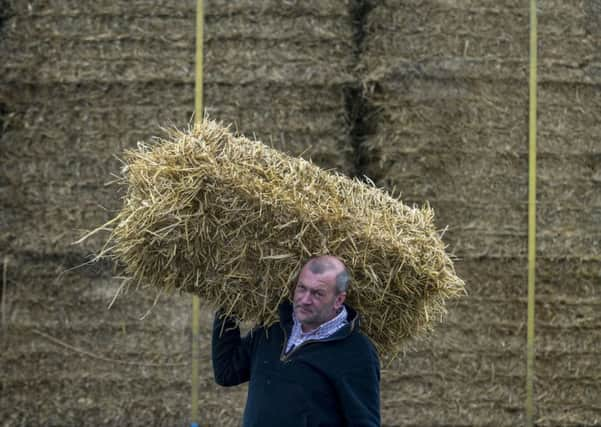Yorkshire traders make hay in changing times for forage


The British Hay & Straw Merchants Association unites those involved with growing, processing or trading forage. It is celebrating its centenary having started out as the British Hay Traders Association in 1916 at a time when there was a huge logistical requirement to feed the near million horses that had been requisitioned to aid the First World War effort in France and Belgium.
Today the emphasis is much more focussed on straw instead of hay as this forms 95 per cent of the market. Association president Mike Evison who trades as JW Evison & Sons at Moat Farm, Fitling in Holderness with his brother Andrew has been baling and trading straw for 25 years.
Advertisement
Hide AdAdvertisement
Hide Ad“We supply local greenhouses with straw for biomass and the rest is split around 50:50 between livestock farms in Scotland and industrial straw for power stations. The demand from power stations has brought our association closer together as we can help each other and by liaising we can sometimes achieve payment on both parts of haulage outward and back-loading by concentrating on logistics. Another area that has grown is selling to mainland Europe. We can sell 150,000 tonnes a year abroad sent on ferries. That’s already happening again this year due in no small part to the exchange rate.”
The Association meets regularly to swap information and highlight problems that warrant further attention. A chief concern at this time of year is supply and where it is based all around the UK.
“There were 33 members at our October meeting in London. Most merchants in the Association are based in the south with a handful up here in Yorkshire and we all gave our views on what kind of harvest we’d had and found out where the straw supplies are based. We meet again in February and May. Our own crop in Holderness is half a tonne per acre down from 1.75 tonnes to 1.25 tonnes per acre on last year and that appears to have been replicated across the country. That means we should not see the mass over production we had last year.”
Brian Peacock who trades as Peacocks of Thirsk at Leake Hall next to the A19 has dealt in hay and straw for 30 years supplying North Yorkshire and southwest Scotland. The Association supplies the average prices of hay and straw to the farming press and when he occasionally receives a call from a customer to query why his may be different to the average, Brian has a quick-witted retort. He also tells of how dairy farm cow numbers and new methods have altered the demand for straw on farms.
Advertisement
Hide AdAdvertisement
Hide Ad“When they ask why mine might be a bit higher price I just say ‘well is it going to walk to you?’ We all have costs to cover and haulage isn’t cheap.
“The two main changes to the demand from dairy farms, particularly those with large herds, have been through feeding and bedding. A lot of big dairy farmers have realised the benefit of mixing wheat straw, which is quite cheap as dry matter roughage, as part of the cow diet. While that has been a positive for us as merchants there has also been a negative in the movement away from straw bedding.”
John Coverdale of Woodhouse Farm, Flixton near Scarborough started trading hay and straw 15 years ago. He delivers from Penrith to Cockermouth and into southwest Scotland. He says there is no longer a mass haul of straw from east to west purely in the autumn and winter.
“Since the advent of industrial straw and farmers keeping livestock in all year round we don’t have a definable three or four month season. We all haul all year round. Dairy farmers want their straw for feed either weekly, fortnightly or monthly and that regular supply is what the power stations are looking for too.”
Advertisement
Hide AdAdvertisement
Hide AdAndrew and Adele Holman trade as A&A Services at Tythe Farm, Cliffe near Selby from where they deliver in an area from Dumfries to Wales. Andrew has been in the straw trade for 45 years. He tells of another factor that affects straw prices.
“We’re in a supply and demand business. Our straw supply has reduced as yields have fallen because farmers are no longer growing varieties that are around 3ft tall. They’re now nearer 18 inches as farmers have concentrated on grain. Some farmers have little interest in straw but the greater their acreage the greater their straw can provide a big cheque.
“The strength of the British Hay & Straw Merchants Association is in bringing us together to find out where the straw is so that we can trade it as profitably as we can.”